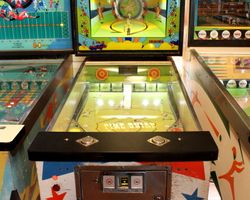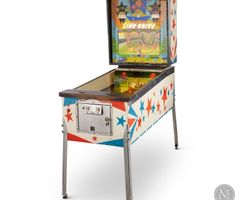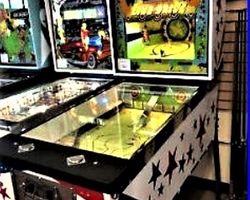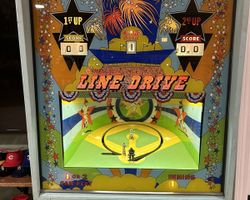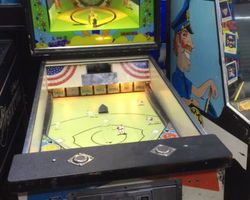Line Drive
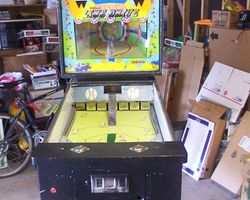
Average Prices: USD $300 to $2,200
Produced: January, 1972
Production Run: 1,501 units
Machine Type: Electro-mechanical
Players: 2
"Line Drive" by Williams Electronic Games, Inc., released in February 1972, stands as a notable example of the electro-mechanical (EM) pinball era, distinguishing itself within the "pitch and bat" specialty game category. Conceived by Williams, a manufacturer with a history of innovation, "Line Drive" aimed to capture the essence of America's pastime, baseball, in an interactive arcade experience. The machine's development, spanning from a production start date of January 20, 1972, to a final ship date of March 29, 1972, resulted in a confirmed production run of 1,501 units. This relatively modest quantity underscores its specialized nature compared to standard pinball offerings of the time. The machine was designed not merely as a pinball game but as a direct simulation of baseball, offering players the chance to hit a ball with a mechanically controlled bat rather than a traditional flipper. This fundamental shift in interaction defined its appeal and set it apart in the arcade landscape of the early 1970s. The game's theme, deeply rooted in the imagery and excitement of a baseball game, was a natural fit for the arcade environment, providing a familiar and engaging scenario for players.
Signature Features and Design
"Line Drive" showcases several distinctive features that define its play experience and visual appeal. Foremost among these is its unique "pitch and bat" cabinet, a departure from the typical upright pinball machine. This design physically positions the player to operate a bat mechanism, offering a direct, tactile connection to the baseball theme. The cabinet itself reinforces this theme with a red, white, and blue color scheme, adorned with star designs that evoke an American ballpark aesthetic. Beyond the cabinet's structure, "Line Drive" incorporates a mechanical backbox animation unit, a sophisticated feature for an EM machine. This unit depicts baseball players running bases in sync with gameplay, providing real-time visual feedback on a player's progress and contributing significantly to the immersive baseball simulation. A backglass light animation further enhances the experience, illuminating with fireworks when a player achieves a home run, celebrating key gameplay moments.
The machine’s sound system was notably advanced for 1972, featuring what were then considered solid-state sound cards. This technology allowed for a dynamic auditory experience, including sirens, cheers, and fireworks effects, all adjustable by the operator for volume and specific sound triggers. This level of audio fidelity and customizability contributed to the machine's ability to create an energetic and authentic ballpark atmosphere. Additional design considerations include light-up coin chutes on the front door, adding a touch of visual flair, and an internal adjustable knob that allowed operators to fine-tune the electrical power delivered to the bat swing. This nuanced control over gameplay mechanics underscored Williams' attention to detail and commitment to a tailored player experience.
Playfield and Mechanics
The playfield of "Line Drive" is crafted to facilitate a baseball-centric game, deviating from conventional pinball layouts to accommodate the pitch and bat mechanics. The design philosophy centers on simulating hitting a baseball, offering a wide-open expanse that encourages powerful, direct shots. The central feature is a prominent, shiny metal ramp, designated as the "home run ramp." This ramp is crucial, as successfully hitting the ball up it routes it to a hanging target, triggering a "Bull's Eye Grand Slam." This shot represents the pinnacle of offensive play, directly tying into the baseball scoring system.
The playfield also incorporates eight hanging targets, which likely represent various scoring opportunities or defensive positions. Colorful bullseye targets light up dynamically as bases are loaded, providing clear visual cues for players to aim for higher scores and understand their progress within the game's simulated innings. The artwork across the playfield and the backglass complements the baseball theme, utilizing a vibrant palette that enhances the overall aesthetic. The lighting is strategically implemented to highlight scoring opportunities and celebrate key achievements, like home runs, through the backglass fireworks animation. Every element, from the layout of targets to the visual feedback, is meticulously designed to immerse the player in the dynamics of a baseball game, moving beyond mere points to simulate runs and innings.
Gameplay Dynamics
The gameplay of "Line Drive" is structured around the core objective of scoring runs, mirroring a real baseball game. Players confront a series of pitches, attempting to hit the ball with the integrated bat mechanism. The game operates on an inning system, with each player getting three "outs" per inning. Operators could adjust the game length to one, two, or three innings, offering flexibility for different arcade settings and player preferences. Progression in the game involves successfully hitting the ball past defensive elements and into scoring zones. The ultimate goal is to hit a home run, achieved by sending the ball up the center ramp to strike the hanging "Bull's Eye" target, which triggers the dramatic fireworks animation on the backglass and registers a significant score.
Beyond home runs, successful hits could advance base runners, represented by the mechanical animation in the backbox. The concept of "bases loaded," where specific bullseye targets illuminate, incentivizes players to strategically aim for targets that convert into higher scores. The adjustable power knob for the bat swing, accessible to operators, could also subtly influence gameplay, allowing for variations in bat responsiveness and adding another layer of depth to player strategy. The challenge lies not just in hitting the ball, but in precise aim to maximize scoring opportunities and advance runners, making each "pitch" a strategic decision rather than a simple reaction. The game's immediate feedback, from the sound effects to the mechanical runner unit, creates a dynamic and engaging experience that keeps players invested in the outcome of each inning.
Reception and Legacy
"Line Drive" has largely been met with a positive reception within the pinball community, particularly by those who appreciate its distinct approach to arcade entertainment. Reviewers often describe the machine as "amazing," "fantastic," and a "solid player," frequently highlighting its engaging and competitive nature. Its ability to foster direct competition between players, encouraging them to get "real competitive," is a recurring theme in feedback. Many appreciate "Line Drive" for being "very unique" and "something very different" for a pinball collection, setting it apart from traditional flipper-based machines.
The machine's sound effects are consistently praised, especially the ability to adjust them, which was forward-thinking for an EM game of its era. The realistic sirens, cheers, and fireworks effects contribute significantly to the immersive experience, enhancing the baseball simulation. The playfield design, particularly the functional and visually appealing "center ramp," and its "wide open" layout for powerful hitting, are often cited as strengths. The colorful bullseye targets and the celebratory backglass fireworks animation for home runs are also frequently commended. The "all American look" of the cabinet and the inclusion of light-up coin chutes add to its aesthetic appeal. Furthermore, the adjustable power knob for the bat swing is noted as a unique feature that contributes to its appeal. While the overwhelming sentiment is positive, with some even recommending it as "the pitch and bat to seek," a lone contrasting view described the playfield as "horrible," though this opinion remains an anomaly among the general appreciation.
"Line Drive" holds a respected position in pinball history not just as a competent electro-mechanical game, but as a defining example of the "pitch and bat" genre. Its blend of mechanical ingenuity, innovative sound design for its time, and a compelling theme ensured its longevity beyond its initial release. The machine's sophisticated mechanical animations, such as the running men in the backbox, showcased Williams' capabilities and hinted at future advancements in interactive arcade experiences. Its success reinforced the viability of sports-themed pinball machines and contributed to the diversity of games available to players. "Line Drive" continues to be sought after by collectors who value its unique gameplay, its historical significance as an early 1970s EM machine, and its ability to deliver an engaging, competitive experience that remains captivating decades after its introduction.
Sponsored Links
 Ebay Listings
Ebay Listings
 Auction Results
Auction Results
| Cost | Location | Date |
|---|---|---|
| USD $2,600 |  Michigan, United States Michigan, United States |
24 April, 2025 |
| USD $1,300 |  Maryland, United States Maryland, United States |
06 June, 2024 |
| CAD $4,250 |  Canada Canada |
09 December, 2023 |
| USD $635 |  United States United States |
02 October, 2023 |
| USD $3,695 |  Florida, United States Florida, United States |
10 March, 2020 |
| AUD $4,200 |  New South Wales, Australia New South Wales, Australia |
09 March, 2020 |
| USD $550 |  Ohio, United States Ohio, United States |
16 June, 2018 |
| USD $3,000 |  Pennsylvania, United States Pennsylvania, United States |
19 December, 2017 |
| USD $1,800 |  California, United States California, United States |
26 July, 2017 |
| USD $1,899 |  Florida, United States Florida, United States |
20 July, 2017 |


Private Policy · Search Website · Contact Us
As an eBay Partner, we may earn a commission from qualifying purchases made through links on this site, at no additional cost to you.
All trademarks and copyrighted materials remain property of their respective owners. All other content copyright 2007 - 2025 Pinpedia.

